HID Lighting – Installation Guide

HID headlamp conversions &
HID auxiliary lamps / spotlights Motorcycle Installation
<< back to HID Lights – Introduction
Information courtesy of www.hid50.com – visit their website for lots more information and prices on HID lighting kits.
| See also: BTBR Light Fitting Service On this page…….. |
Installation of HID lighting – Fitting to Motorcycles
HID Conversion Kit Installation for BMW motorcycles (Example R1200GS)
HID Ballast location examples (R1200GS / 1200GSA – photos & notes)
HID Ballast Mounting Brackets (R1200GS / 1200GSA – photos & notes)
Converting Other Lights (Fog lights & driving lights conversions)
Installation of HID lighting – Fitting to Motorcycles
When fitting to bikes carry out the installation in 3 steps:
(1) Find where you want to locate the ballasts and mount them – make sure they are close enough to the headlights for the cables to reach – it’s near impossible to extend them. I have my R1200GSA headlight ballasts between the screen and the back of the instrument panel. Others have chosen different locations. There is no best answer. But do note that if you mount under the oil cooler on a GS or GSA, the forks “move forward” under compression, so the ballasts can not project further back than that rear edge of the oil cooler. Some end up getting custom brackets made up for the ballasts, others just mount using the brackets in the kit. Everyone seems to find different locations to mount the ballasts. You have to be creative with motorbikes re ballasts mounting. There is always room though, I have 6 ballasts on my R1200GSA … you just have to find the room.
(2) Remove the headlight unit and do the fiddling around with the burners that way. Trying to fit the new burners without removing the headlight unit is a recipe for frustration swearing and skinned knuckles – and therefore misery. You will also need a 23-25 mm (1 inch) drill bit (you need to make a circular hole on the back of the headlight units two round caps.)
(3) Connect everything up. And power up !
Note: BMWs have unique wire colours:
- White wire : high beam positive
- Yellow wire : low beam positive
- Brown wires : earth (negative)
Also note that sometimes the kits come with slightly different wires that are nominated in the installation booklets. The booklets refer to red being positive and black negative. Usually that’s the case with the kits but occasionally I get kits with blue and black wires. In those examples, the black wire remains negative, and the blue wire is positive.
Here it is again in a bit more detail:
HID Conversion Kit Installation for BMW motorcycles (TOP)
- Remove Headlight unit from motorcycle, ensuring motorcycle is switched off. No need to remove battery.
- Unscrew the plastic caps at the back of the housing that provide access to the bulbs.
- In the centre of the two plastic caps that were removed earlier, drill a 23-25 mm (1 inch) hole (with a hole saw bit or a flat wood bit).
- Unlatch the bulb retaining spring clip, and remove the old halogen bulbs. The plastic that holds the spring clips is brittle and prone to break. Be careful.
- Pass the bulb and two wires with open spade connectors through the newly drilled out hole in each plastic cap until the rubber grommet is seated in the newly drilled hole.
- Insert new HID bulbs, ensuring they are correctly aligned. Note that the 4 wires will slide back and forwards through the grommet. I advise that when you are fiddling around getting the bulb in, that you pull as much wire to the bulb side of the grommet as possible to avoid skinned knuckles and excess frustration. When seating the new bulbs, the H1 is hard to get wrong, but the H7 is easily gotten wrong. Make sure the bulbs are correctly seated before closing the bulb retaining spring clip, again taking care not to damage the poorly made housing around the base of the spring clip.
- Connect the spade connectors up to the motorcycle’s headlight power. (see 8 and 9 below for H7 and H1 respectively)
- The spade connectors attach to the contact block that previously plugged into the back of the bulb. On a H7 kit, the brown BMW wire (negative) needs to lead to the black spade connector wire (negative). And the white or yellow BMW wire (positive) needs to connect to the blue or red spade connector wire (positive).
- On a H1 kit, the BMW earth is plugged to the headlight housing and needs to be removed before connecting to the black spade connector. They may need to be crimped together with a pair of pliers if they are different shapes. The wire that connected to the H1 bulb is the positive and needs to be connected to the blue or red wire’s spade connector.
- Plug the wires that come from the bulb into ballasts with the “its impossible to plug in the wrong way” connectors and check the HIDs have been wired up correctly by turning the appropriate lights on. Note both ballasts in the kit are identical, so you do not need to pair a particular ballast with a particular bulb.
- Close up the headlight unit by screwing back in the plastic caps. Note that the 4 wires will slide back and forwards through the grommet. It is advisable to pull out excess wire from the headlight housing as you close the unit, to avoid having too much crowded wiring inside the cramped headlight housing. Similarly, I advise that when you are fiddling around getting the bulb in, that you pull as much wire to the bulb side of the grommet as possible to avoid skinned knuckles and excess frustration.
- Next stage … mounting the ballasts. It’s really up to each individual to mount ballasts and a number of different brackets and locations are possible. Make sure the ballasts are mounted so that their cables can comfortably reach the appropriate bulbs. Some kits have large general mounting brackets, while the ultrathin kits are expected to be screwed or otherwise attached to a flat clean surface. Increasingly, my mounting of choice is to use strong double sided tape or industrial velcro for the smaller kits. See below for more info on industrial velcro, and note the first 3 pictures have UltraThink HID ballasts attached with Dual Lock industrial velcro.
Note: HIDs tend to take a few hours after first use to really get the power, light levels and light colour at full power and stable colour, so use them liberally initially to bed them down – up to the first 2-3 months you may find the brightness of the lights increases.
HID Ballast location examples (R1200GS / R1200GSA) (TOP)
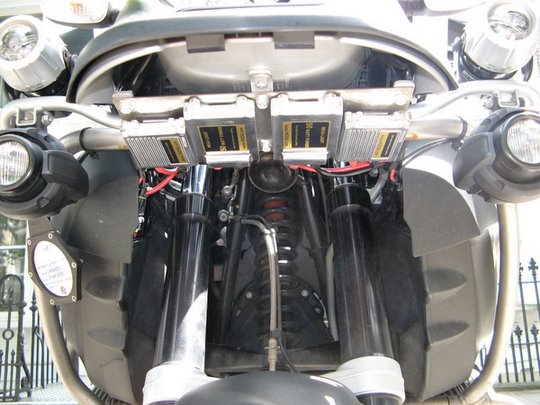
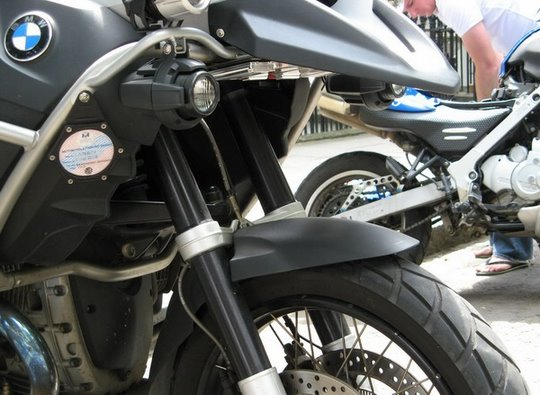
In the above two photos the four fog and driving light ballasts (two Ultra35s and two Ultra50s) are attached to a custom plate using 3M’s Dual Lock industrial velcro, which I can supply (see below)
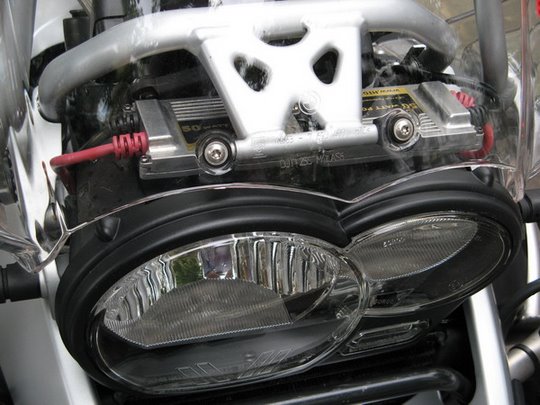
In the foto above, the two headlight ballasts are attached to the top of the headlight unit using nothing but small patches of Dual Lock

The foto above shows space inside the steering well where a larger ballast can be mounted on each side of the 1200 GS / GSA bike
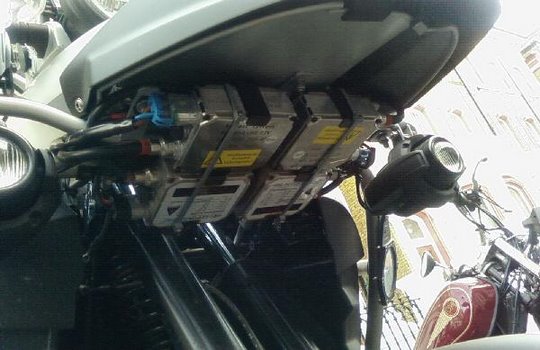
Plenty of space under that big old beak. Here 4 big old ballasts fit comfortably and out of sight from normal viewing angles.
HID Ballast Mounting Brackets (TOP)
There are custom made ballast mounting brackets available for the BMW 1200 GS and GSA. We don’t manufacture or sell them but we do recommend them and can put you in touch with the manufacturers of these:
(1) The Wassall Bracket
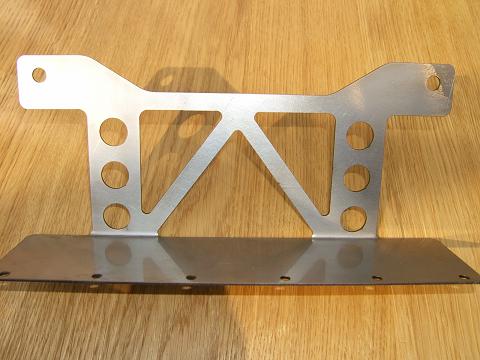
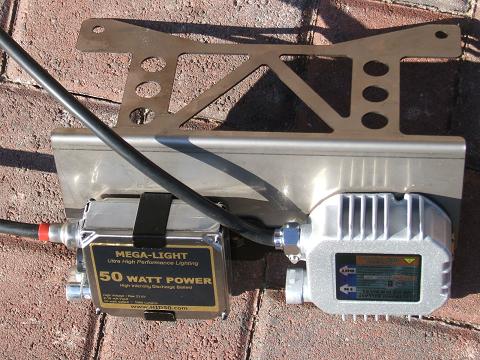
2 Pics above: The Wassall bracket. Its versatility is that it is able to handle any ballasts, large or small. This is useful if you ever need to change to a different style of ballast at a future date. Its upgrade friendly. You can fit up to 4 of the new UltraThin ballasts side by side on a Wassall bracket.

Pics above and below: The Wassall bracket fitted with UltraThin ballasts (above) and with regular ballasts (below).
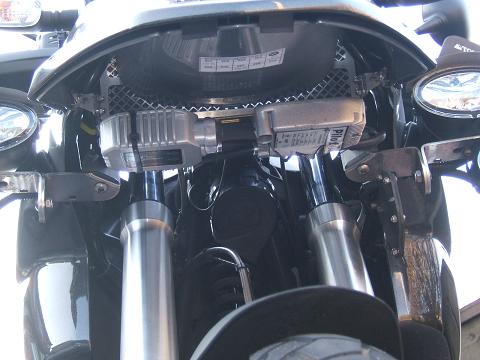
(2) The Cook Bracket

Pic above, a new Cook bracket for the Ultra50 ballasts, in a fetching black finish. Its advantage is its lightness and simplicity. For the simple task of mounting HID50s latest UltraThin ballasts, the Cook bracket is the simplest and lightest custom under beak bracket that we know of. Fitting the bracket is very quick, simple and easy.

Pic above shows the Cook bracket fitted

Pic above shows the Cook bracket and ballasts fitted
Dual Lock Adhesive Tape
All HID50 ballasts are flat on the back and can be securely mounted with the likes of 3M “Dual Lock” tape.
The brackets that come with the Finned kits are simple to mount but in small spaces they can restrict flexibility. In tight spaces the Dual Lock mounting may afford more mounting options.
The top three pictures above are my own bike and the 6 ballasts are all mounted with Dual Lock industrial velcro. The top two pictures have 4 ultrathin ballasts mounted under the beak of the bike on a stainless steel plate. The third picture shows two more ultrathin ballasts, mounted with dual lock to the top of headlight unit,
between the screen and the clocks.
Fitting
If you don’t fancy fitting your own HID set we (www.HID50.com) can put you in touch with people who can fit your HIDs to your headlights for around £30 a pair.
Converting Other Lights (Fog lights & driving lights conversions) (TOP)
It is possible to convert lights other than headlights to HID. Halogen fog lights and driving lights are all potentials for conversion to HID. Doing so will increase the light output dramatically, while lowering power consumption. To install these fog / driving light conversions you will need a more detailed knowledge of wiring and some conversions require special adapter plates (unlike a simple headlight conversion). HID50 can put you in contact with people who can supply you will fully converted spot or driving lights, giving you the power of 35 or even 50 watt HIDs with latest technology UltraThin HID50 ballasts for a fraction of the cost of “off the shelf” HID driving lights (that invariably come with older generation bulky ballasts).
The beam patterns from these conversion are perfect, with razor sharp cutoffs on the foglights and a significantly increased projection on the driving lights. HID fog and driving lights provide the absolute ultimate in vehicle illumination.

Above and below … Hella Micro DE foglights, converted to HID (yes, in the picture below its daylight and the headlights are on. It just that the power of the HID fogs overwhelms both the daylight and the headlights)
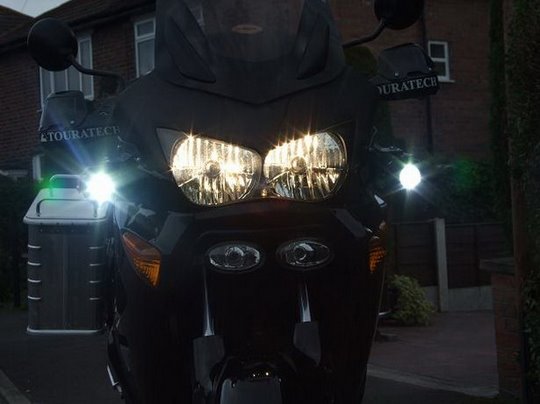
…….it’s a Honda Varadero
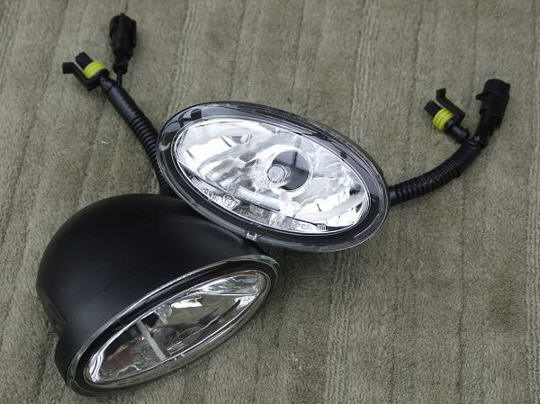
Above: Hella FF50 driving lights, converted to HID units
The BMW fog lights, optional on the R1200GS Adventure, converted to HID
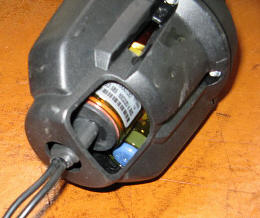
Finally: Note that we do not claim to be legal experts and can give no advice as to the legality of operating any HID conversion (35 watt or 50 watt) or any other lighting modification due to the widely varying road regulations in different regions and countries. Anyone who does claim to be able to give you any definitive answer is talking through his/her hat. As with any aftermarket accessory, its up to the buyer to determine how he uses the HID kit. For the record, we sell HIDs for off road and farm use, underwater lighting, photographic and film lighting.